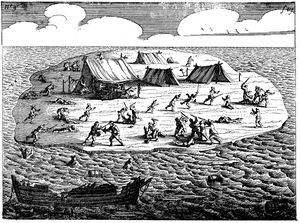Jeronimus Cornelisz
Jeronimus Cornelisz (Leeuwarden 1598 - October 2, 1629) (properly Corneliszoon, 'son of Cornelis') was a Frisian apothecary and Dutch East India Company (VOC) merchant. In June 1629 he led one of the bloodiest mutinies in history after the merchant ship Batavia was wrecked in the Houtman Abrolhos, a chain of coral islands off the west coast of Australia.
Early life
Born in the Frisian capital, Leeuwarden, Cornelisz grew up in a non-conformist household. His mother and probably his father were Mennonites, members of an Anabaptist church. It has been speculated that they may have had links with some of the more militant Anabaptist movements, such as the Batenburgers, that flourished in the Netherlands during the sixteenth century.
The young Jeronimus was well educated, probably at the Latin School at Dokkum, and followed his father into the family trade by training to become an apothecary. He qualified around the year 1623 and practiced in his home town until 1627, leaving in that year apparently as a result of disagreements with the town council.
Cornelisz moved to the much larger Dutch city of Haarlem, where he opened up an apothecary shop near the centre of the town. In November 1627 he and his wife had a son, but the child died less than three months after being placed in the care of a wet nurse. The cause of death was established as syphilis, and Cornelisz became embroiled in a legal action against the nurse, seeking to prove that his child had contracted the disease from her and not from his wife. Perhaps partly as a consequence of this distraction, his apothecary shop shortly thereafter failed and Cornelisz himself was driven to the brink of bankruptcy.
Batavia
It was widely believed, though it has never been proven, that Jeronimus became acquainted with the controversial painter Johannes van der Beeck ('Torrentius'), another Haarlem resident, at about this time. Torrentius was a notorious libertine and suspected heretic, and in 1627 he was tried and sentenced for his religious beliefs. Whether or not Cornelisz was a member of Torrentius's circle, or shared his heterodox beliefs, he certainly left Haarlem within weeks of the end of the painter's trial, going to Amsterdam and taking service with the Dutch East India Company, or VOC. He was posted to the new ship Batavia, which sailed for Java in the East Indies in October 1628.
Cornelisz, whose main motive in sailing for the East seems to have been to recover from his crippling financial position, became friendly with the Batavia's skipper, Ariaen Jacobsz, in the course of the ship's long voyage. He and Jacobsz became discontented with the leadership of the commander of the ship, the merchant Francisco Pelsaert, and plotted a mutiny. Before the plot could be put into effect, however, the Batavia ran aground in the Abrolhos archipelago and was lost. More than 200 survivors made their way ashore, and when Pelsaert and Jacobsz set off for help in the only boat, Cornelisz was left in command on the islands.

What followed horrified all Europe. Cornelisz established a brutal personal rule in the islands, backed by a core of men who had plotted with him on board ship. When food and water supplies became scarce, the mutineers began to kill their fellow survivors, at first covertly, then more and more openly. In all, Cornelisz and his henchmen were responsible for the deaths of between 110 and 124 men, women and children over a two month period. Their victims were drowned, strangled, hacked to pieces or bludgeoned to death singly or in large groups. Surviving women were forced into what amounted to prostitution.
Cornelisz's rule in the Abrolhos was challenged by a group of loyalists, led by a common soldier, Wiebbe Hayes, who managed to establish themselves on a nearby island. Their survival made it impossible for Jeronimus to carry out his intention of seizing any rescue ship, massacring its crew and turning pirate in the Indian Ocean, and when Pelsaert eventually returned in a small ship called the Sardam, Cornelisz and his men were captured.
Execution
Jeronimus was tried in the islands, found guilty of mutiny, and hanged along with half a dozen of his men. Both of his hands were amputated prior to the hanging (it appears with a hammer and chisel). The remaining mutineers were taken back to Java and tried; many were subsequently executed. Ariaen Jacobsz apparently died in the dungeons of Castle Batavia.
Psychopathy
In the historical work, "Batavia's Graveyard", which analyzes the incident in more detail than ever before based on research in Dutch archives amongst other sources, author Mike Dash theorizes that Cornelisz was almost certainly a psychopath. This is shown by his often erratic behavior on the islands, his unattainable dreams of setting up a personal kingdom in the islands, and his complete assurance that he could do no wrong and that God himself inspired all of his deeds. This ties in with the heretical ideas he had picked up during his acquaintance with the controversial painter Johannes van der Beeck, also known as Torrentius.
In popular culture
A character in Warren Ellis' comic book Desolation Jones is named after Jeronimus Corneliszoon.[1] A fictionalised version of Jeronimus is the main character of "The Company" by Arabella Edge, which is based on the shipwreck of the Batavia.
Books
- Dash, Mike. Batavia's Graveyard: The True Story of the Mad Heretic Who Led History's Bloodiest Mutiny. New York: Three Rivers Press. 2003. ISBN 0-7538-1684-9
- Drake-Brockman, Henrietta. Voyage to Disaster, 2nd ed., 1995, University of Western Australia Press, Nedlands.
- Roeper, VD (ed). De Schipbreuk van de Batavia, 1629. Zutphen: Walburg Pers. 1994.

